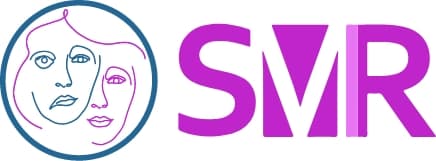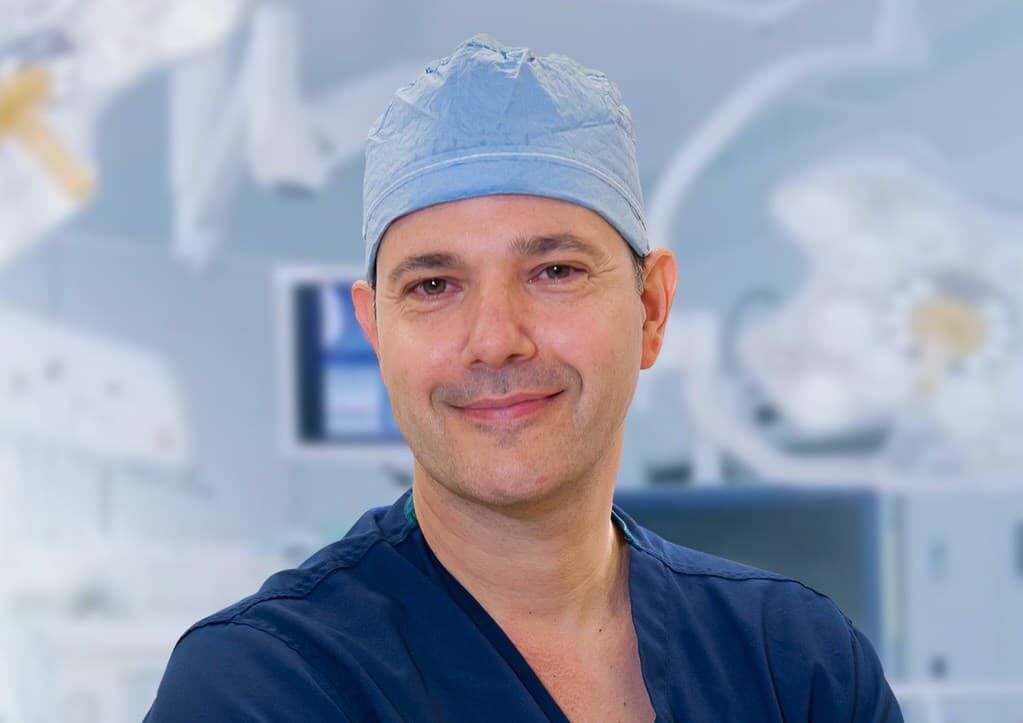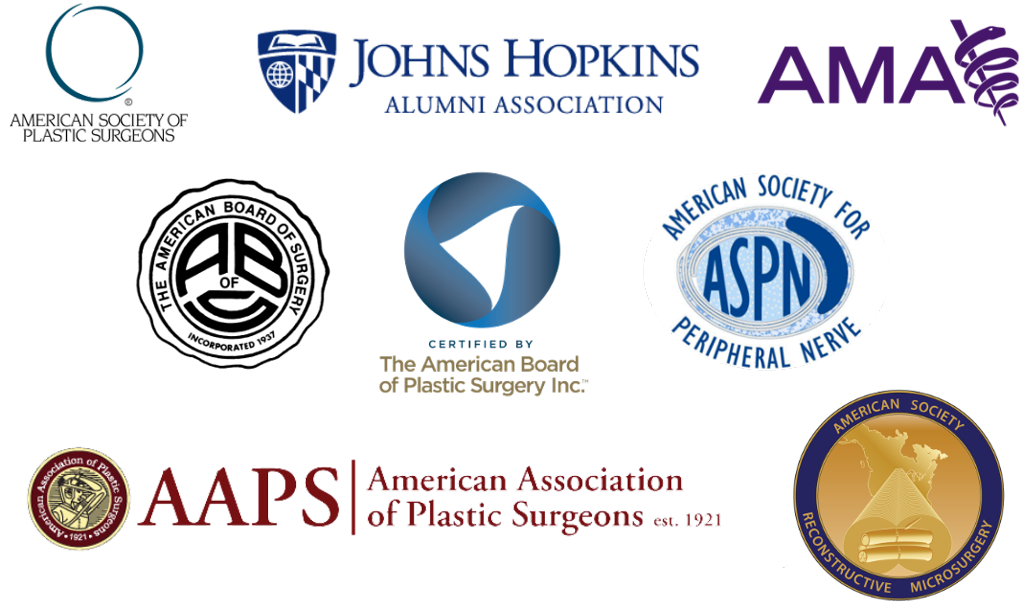Shai M. Rozen, M.D., F.A.C.S.
1801 Inwood Road
Dallas, TX 75390
Phone: (214) 645-2353
Monday–Friday: 8 a.m.–5 p.m.
Free Functional Muscle Flap
There is no exact time frame that defines facial paralysis as long-standing or chronic. In general, when paralysis lasts longer than 18 months, the muscles of the face atrophy and the chances of salvaging muscles are low. Once this occurs, facial reanimation requires the transplant of a new muscle with its blood and nerve supply from elsewhere in the body called a free functional muscle flap.
At the University of Texas Southwestern Medical Center, Dr. Shai Rozen, a leading facial paralysis surgeon, known nationally and internationally for his contributions to the area of facial paralysis and his team, perform complex facial reanimation procedures to help adults and children restore facial function and appearance. It is important for patients to understand they are not alone and that much can be done to improve facial function and balance. Early treatment allows for the best results; however, patients with long-standing paralysis can be helped as well.
Stage 1: Cross Facial Nerve Graft
First, a cross facial nerve graft (CFNG) is performed, during which a nerve is taken from the leg and connected to the facial nerve on the healthy side of the face using advanced microsurgical techniques. The nerve is then crossed under the skin of the face to the paralyzed side. Over the next 8 to 12 months, the nerve grows. Once it reaches the paralyzed side, Dr. Rozen plans the second stage of the surgery, which is the muscle transplant.
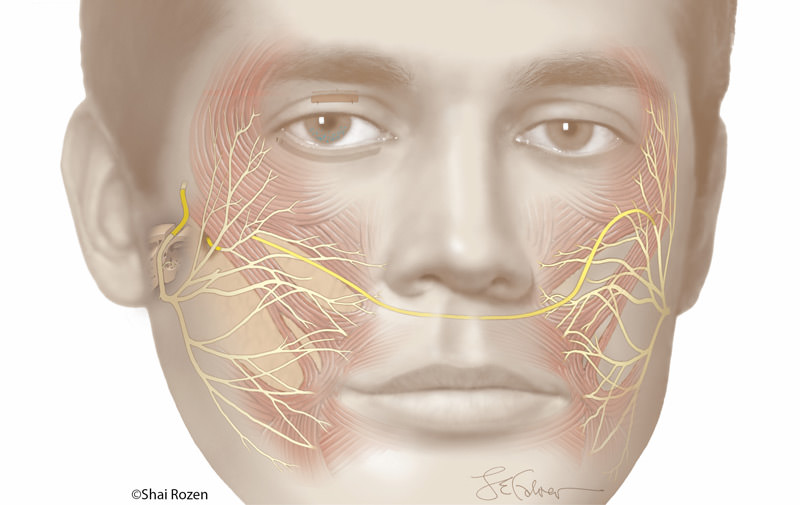
This figure depicts several techniques used in the treatment of facial paralysis, including cross facial nerve graft, nerve transfer, and intratemporal nerve grafting. The cross facial nerve graft is seen here as the yellow structure that crosses from one side of the face to the other.
Stage 2: Muscle Transplant
If the gracilis muscle is chosen for transplantation, after making an incision of approximately 8 inches on the inner thigh, the surgeon removes a small portion of the muscle along with its blood supply and appropriate nerve, the anterior branch of the obturator nerve. The donor site at the thigh is closed, usually with a drain that is removed in the clinic a week or so later.
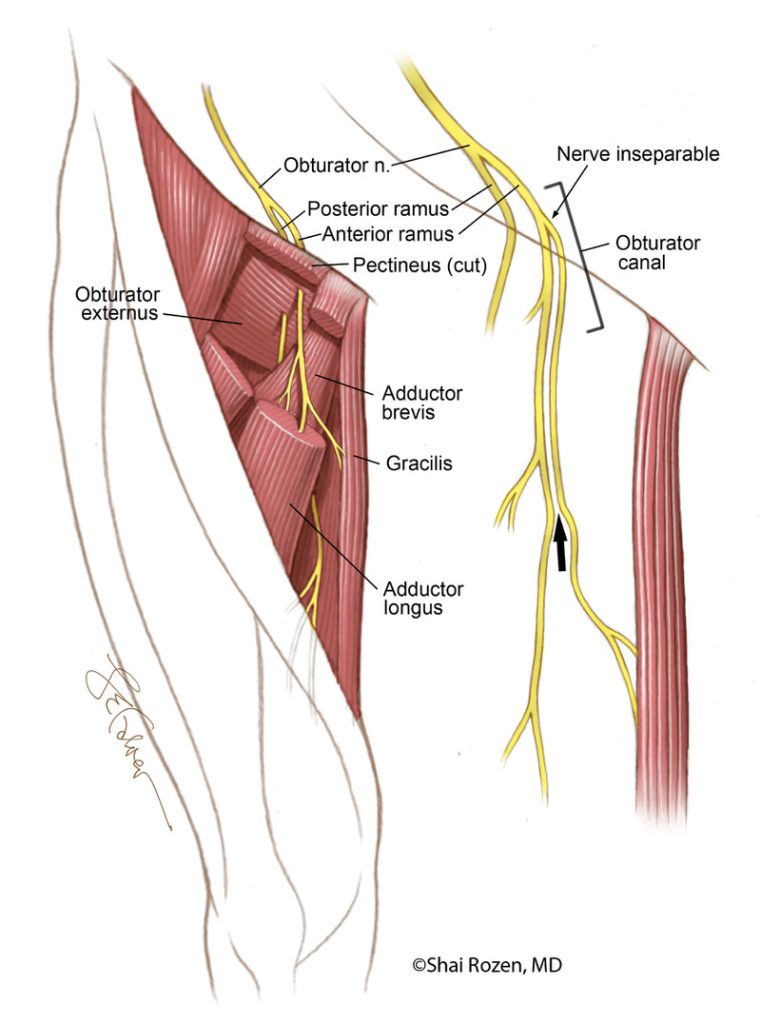
This figure depicts the gracilis muscle which is commonly used for muscle transplantation and its innervation.
At this point, the muscle is very accurately secured into the paralyzed side of the face. This is one of the more important aspects of the surgery since correct placement will dictate the shape and direction of the smile. Once muscle placement is complete, both an artery and a vein are connected under a microscope with sutures that are approximately 0.03 mm thick (around 1/3 the thickness of a human hair). When blood flow is re-established, the nerve or nerves are attached with similar sutures, based on how the innervation pattern was planned.
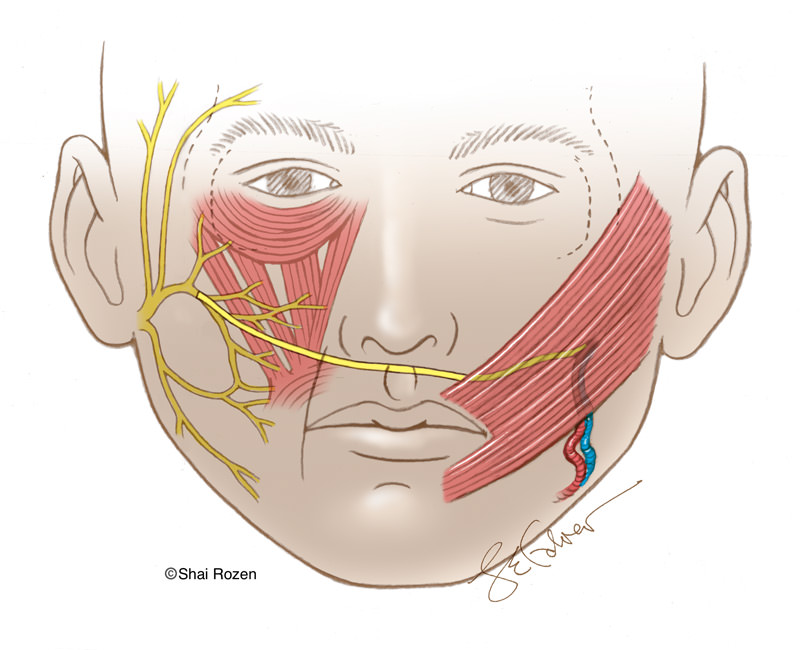
This figure depicts a transplanted muscle that is connected to a previously placed Cross Facial Nerve Graft. The muscle is intended to pull on the paralyzed mouth to help recreate a smile and provide a more symmetric and balanced smile.
Free functional muscle transplant in one stage – how is it performed?
While similar to the two-stage technique in certain aspects, the one-stage technique differs by the nerve that innervates the transplanted muscle and that the procedure is performed in one stage. This nerve is a non-facial nerve (most commonly the Nerve to Masseter) on the paralyzed side that usually has not been affected by the paralysis and can be used to innervate the muscle. If this technique is chosen, there is no reason to wait until the CFNG has grown, and the muscle transplant can be performed in one stage. The remainder of the management is similar to when a two-stage technique is used.
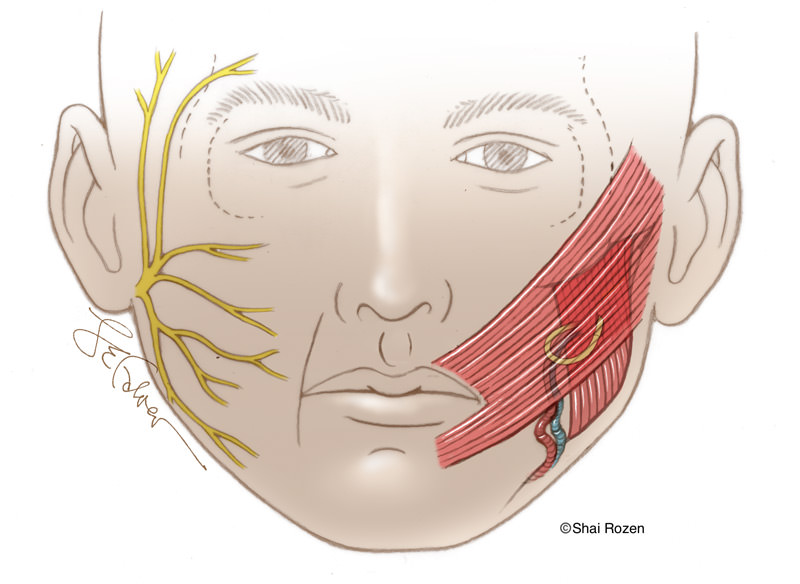
This figure depicts a transplanted muscle that is connected to a nerve to masseter performed in one stage. The muscle is intended to pull on the paralyzed mouth to help recreate a smile and provide a more symmetric and balanced smile.
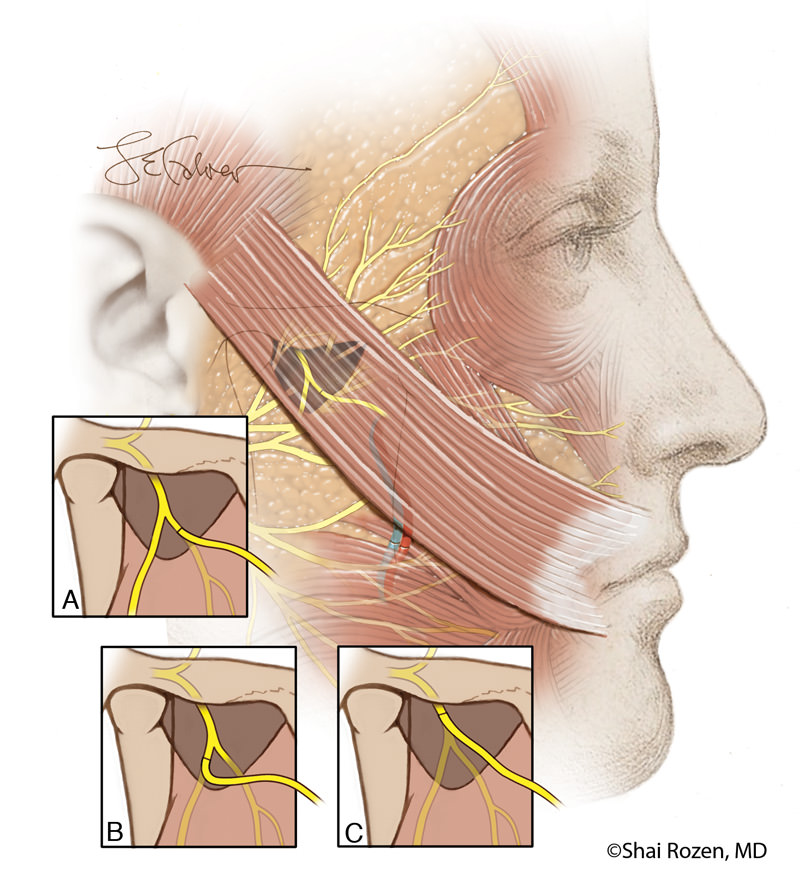
This figure depicts a side view of a transplanted muscle being innervated in one stage by a nerve to masseter. This is depicted in Dr. Rozen’s article on different salvage techniques with the nerve to masseter in difficult cases. Reuse of The Masseteric Nerve for Dynamic Reanimation in Facial Palsy Patients with Previously Failed One-Stage Dynamic Smile Reanimation. Plast Reconstr Surg. 2019 Feb; 143(2):567-571; DOI: 10.1097/PRS.0000000000005253. PMID: 30688904
What is the difference between using one-stage and two-stage techniques?
Each of these techniques has its own advantages and disadvantages and is used based on multiple patient factors that come into play. These considerations include the patient’s age and the extent of damage to other nearby nerves, as seen more commonly in certain situations of cancer, neurofibromatosis type 2 (NF2), or severe trauma.
Two-stage Techniques Using the Facial Nerve
The use of the facial nerve via a cross facial nerve graft has the advantage of providing spontaneity (the patient doesn’t need to think about smiling when smiling), but in adults, cross facial nerve grafts will often render a weak smile when innervating the transplanted muscle.
One-Stage Techniques Using a Non-Facial Nerve (Masseteric Nerve)
Conversely, the use of a non-facial nerve to innervate the muscle will provide significant strength to the smile, but spontaneity is not always observed. Most patients will NOT need to bite down when the masseteric nerve is used as with a temporalis muscle flap, and will be able to readily smile voluntarily but will often need to remember to smile if something makes them laugh spontaneously. For this reason, we sometimes use dual innervation techniques.
The techniques described above are some of the basic techniques used in facial reanimation, but there are additional combined techniques of innervation (such as dual innervation techniques) that may be performed. Keep in mind, the smile, albeit very important, is usually just one aspect of the treatment plan. The exact approach varies between patients and should be discussed individually with Dr. Rozen.
Dr. Shai Rozen
Dr. Rozen is a board-certified plastic surgeon who co-created a facial paralysis specialty group with colleagues from otolaryngology & neurosurgery at the University of Texas Southwestern Medical Center.
Meet Dr. Rozen
How will the muscle move after it is transplanted?
Muscles can only function if a nerve innervates them. Several nerves may innervate the transplanted muscle based on the pre-operative plan. If a CFNG was previously transplanted, it can be used. In many pediatric patients, this may be the only nerve used to innervate the muscle. The main advantage of using the CFNG as the innervator of the muscle is that it gives patients the ability to smile spontaneously.
In older patients, the muscle is innervated by both a CFNG and another nerve, most commonly the nerve to masseter (NTM)—referred to as dual innervation. This technique is designed to provide both strength and spontaneity of the smile.
A Valuable Resource for Those Affected by Facial Paralysis
If you, a loved one, or a patient is affected by facial paralysis, it’s crucial to have accurate, up-to-date information about symptoms and solutions. Board-certified plastic surgeon Dr. Shai Rozen, a specialist in facial paralysis and facial aesthetics, created Your Guide to Facial Paralysis & Bell’s Palsy to be a readily accessible resource for all.
This downloadable, printable e-book makes it easy to understand:
- How paralysis affects the face
- When it’s time to see a specialist
- Common causes of facial paralysis
- The difference between facial paralysis and Bell’s palsy
- Myths and facts
- The latest treatment options
- Answers to common questions
Get your free copy today—to download or view in your web browser—by completing the following fields:

How long does it take for the muscle to move after it is transplanted?
On average, the transplanted muscle starts moving between 3 to 6 months after the transplant. This timeframe varies with several factors, including:
- Patient’s age
- Type of nerve used
- Quality of the original nerve graft
- Size of the donor nerve
In some patients, it may take longer to restore motion. Changes in the quality and strength of the smile may even take a few years with slow incremental improvements.
What should I expect after muscle transplant surgery?
Once the surgery is completed, a small drain is inserted in the face and is usually removed before discharge from the hospital. A small tape is applied to the face on which “No Pressure” is written as a reminder for the patient and others to avoid pressure or getting hit in the face over the next 3 weeks. Patients typically stay in the hospital for 1-2 days after surgery.
Next Steps
Dr. Rozen and his team have helped many adults and children smile again with free muscle flap procedures and other types of advanced facial reanimation surgery. To get started, request a consultation online to meet with Dr. Rozen at UT Southwestern. The sooner you seek treatment, the more options you have available.
